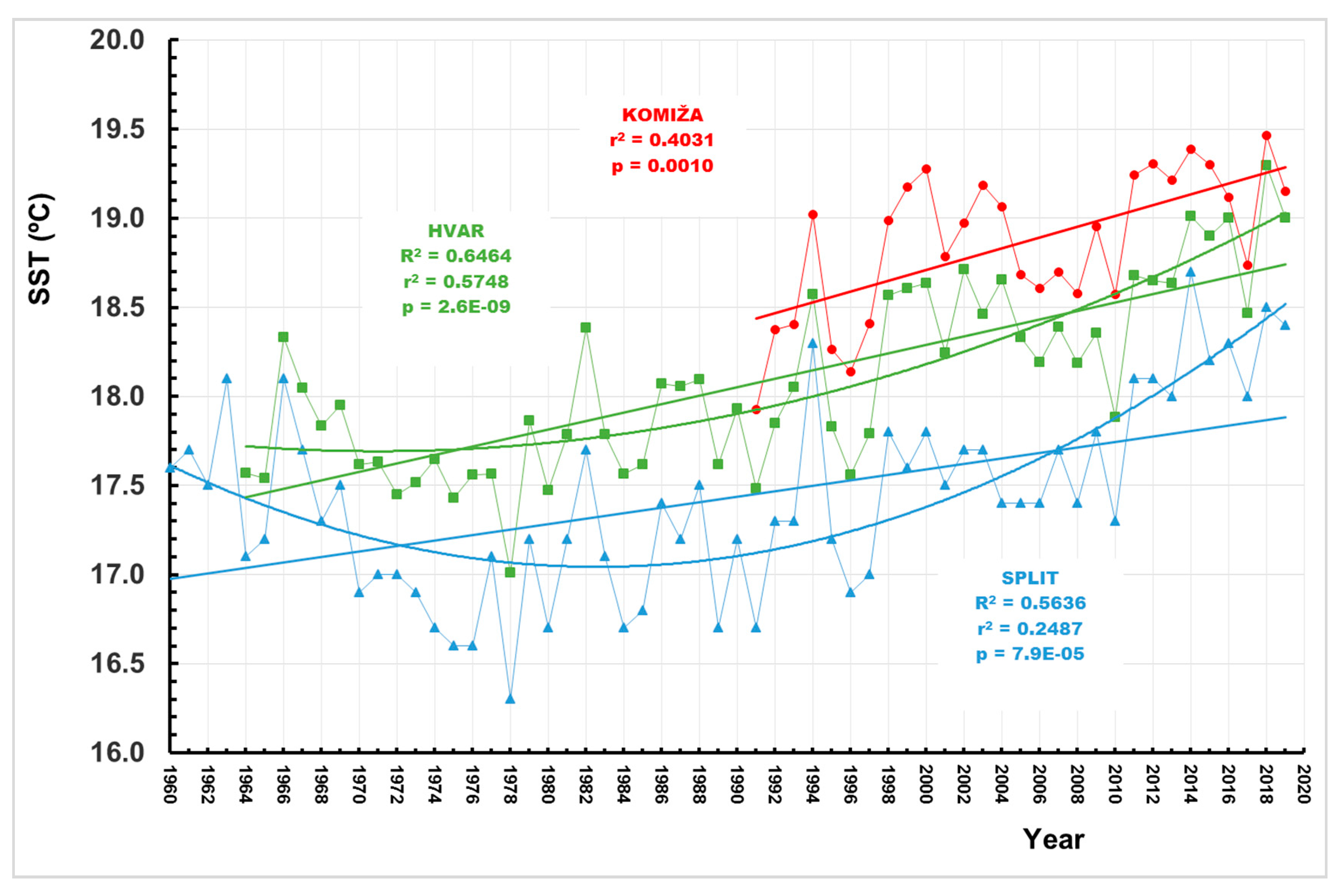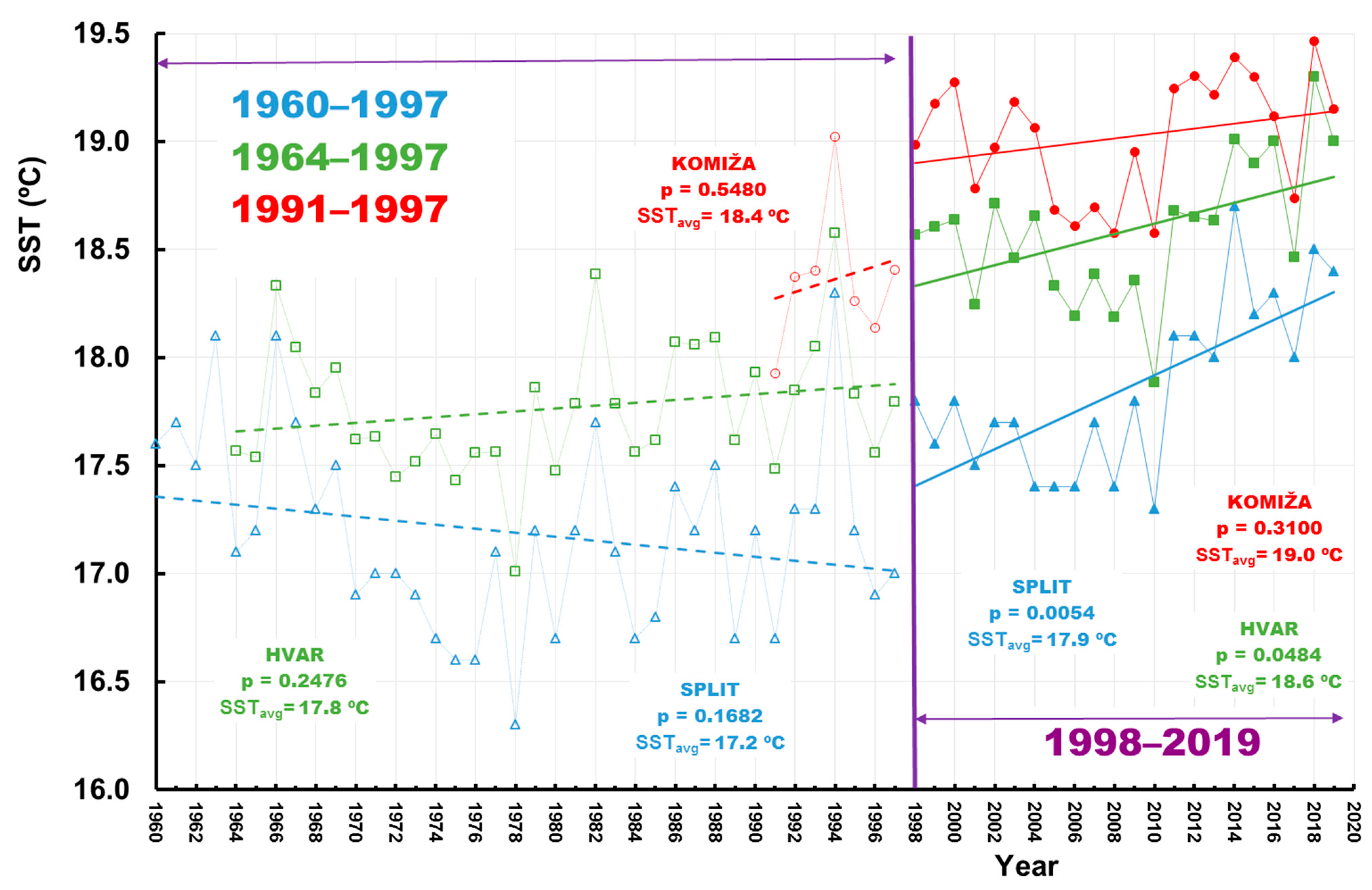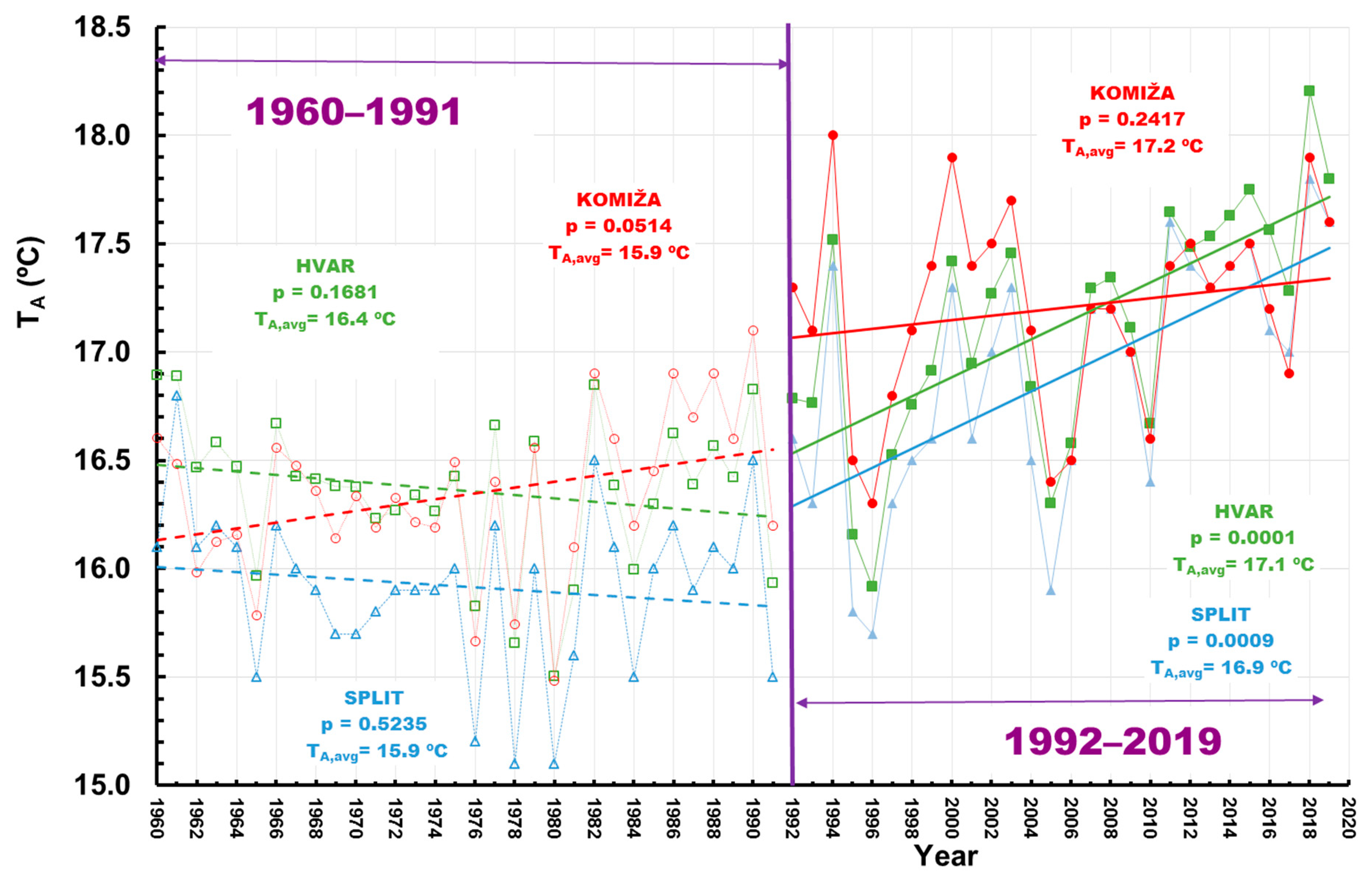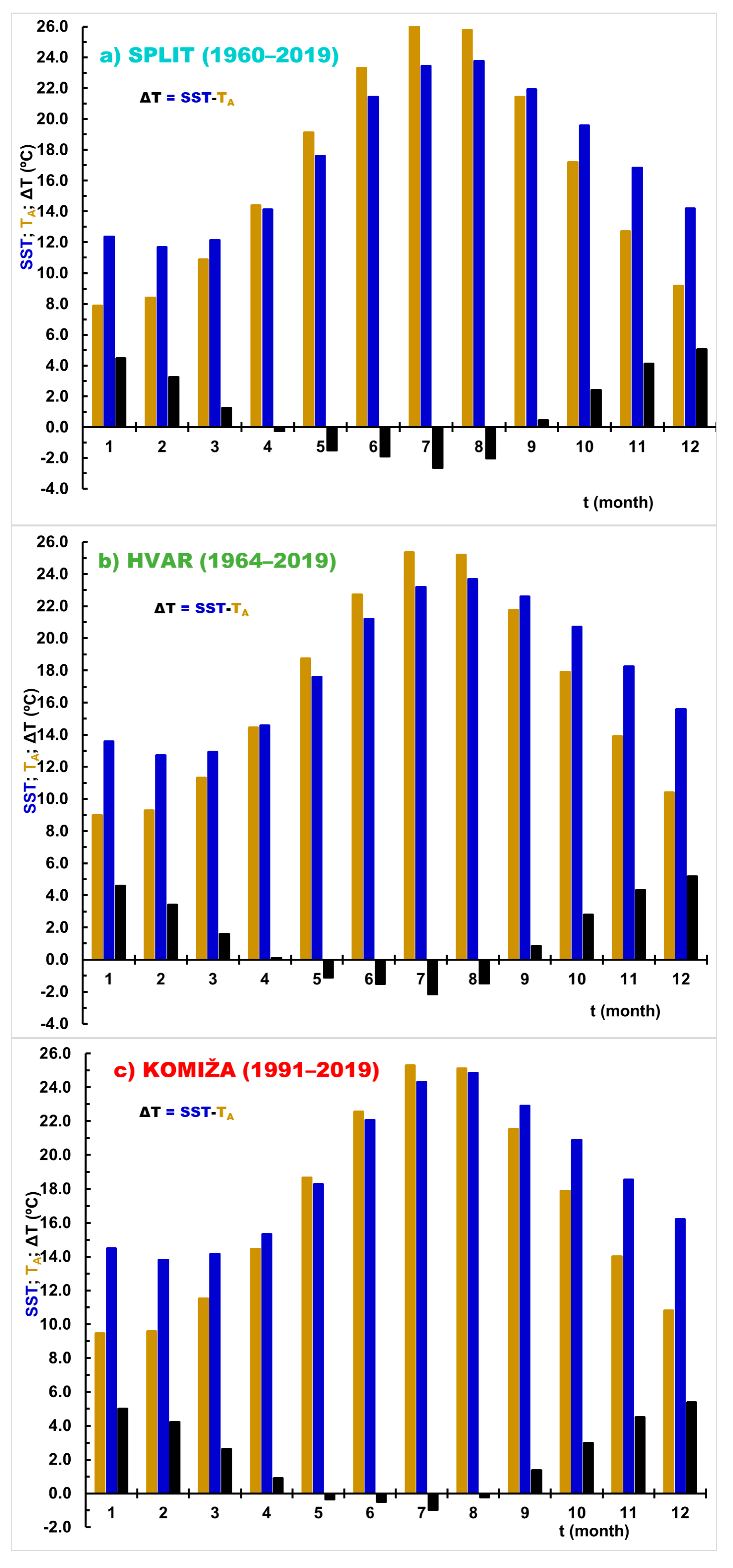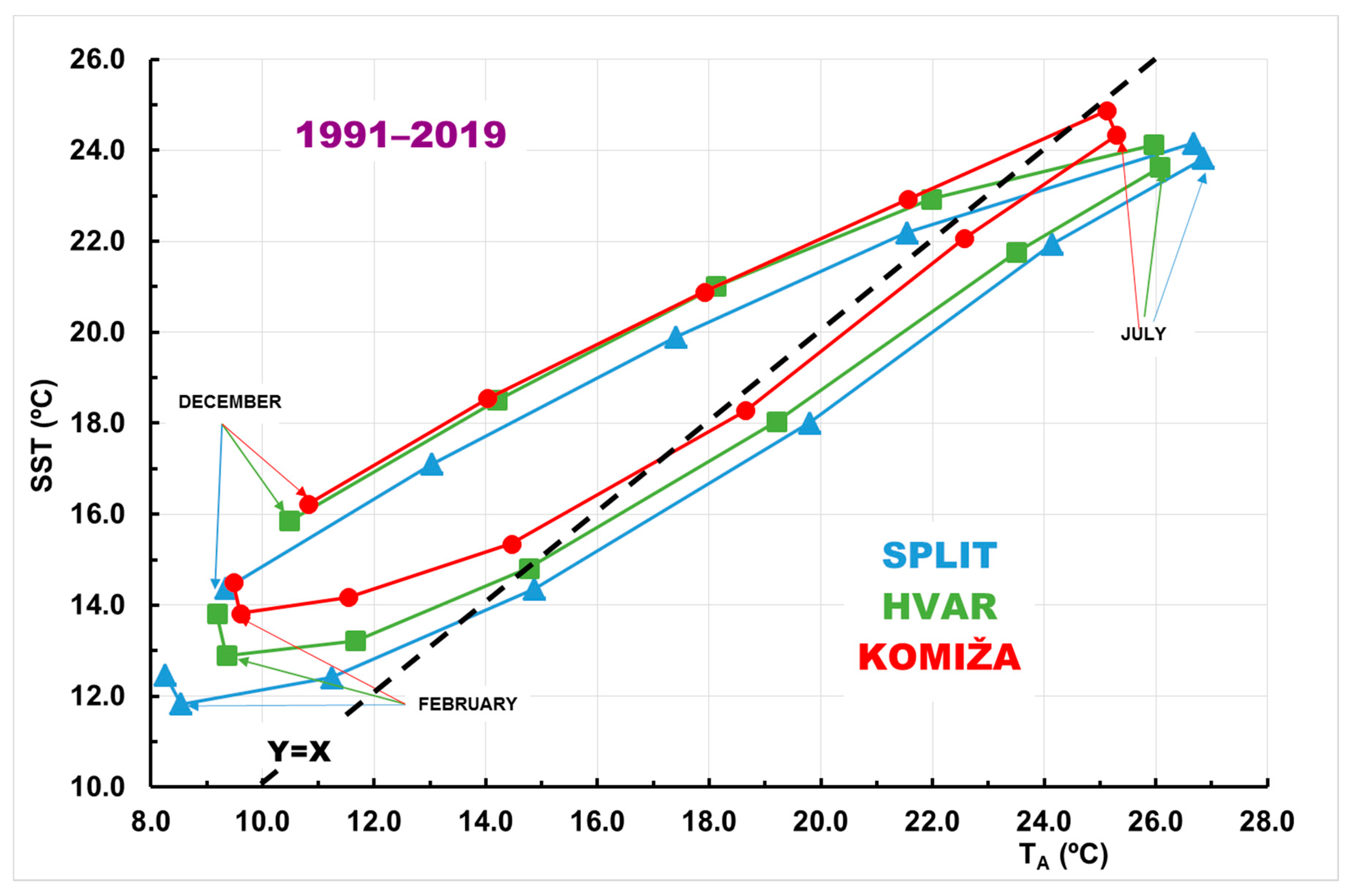In this chapter, temporal changes in the mean annual and the mean monthly SST and air temperature were analyzed. The analyzed time series are not identical in duration, which will affect the reliable comparison of the results obtained at three analyzed stations to a minor extent. Despite the differences in the duration of the analyzed time series, contemporaneous time series were available for the last 29–year period (i.e., 1991–2019), when the most significant increases in the SST and the air temperature were observed. This fact will allow a more reliable conclusion about the recent and future behavior of the SST and the air temperature in the study area.
4.1. Analyses of the Mean Annual Sea Surface Temperature and Air Temperature
Table 2 shows a summary of the exploratory statistical analysis (minimum, average, maximum, and range) of the mean annual SST, the air temperature (T
A), and their difference (ΔT = SST–T
A) at the analyzed stations. The longest time series analyzed in this study were recorded in Split (from 1960 to 2019), followed by Hvar (from 1964 to 2019), and Komiža with the shortest time series (from 1991 to 2019).
The minimum, average, and maximum values of the mean annual SST measured in Split were 16.3 °C, 17.4 °C, and 18.7 °C, respectively. The values measured at Hvar were slightly higher being 17 °C, 18.1 °C, and 19.3 °C, respectively. Komiža had the highest values of SST, with the minimum, average, and maximum mean annual SST being 17.9 °C, 18.9 °C, and 19.5 °C, respectively. The range of the mean annual SST was 2.4 °C, 2.3 °C, and 1.6 °C in Split, Hvar, and Komiža, respectively. The lowest range of the mean annual SST in Komiža reflects its furthest position in the open sea among the analyzed stations.
The distribution of the air temperature (TA) values was similar to the SST in terms of Split having the lowest values and Komiža the highest. The minimum, average, and maximum values of the mean annual air temperature measured in Split were 15.1 °C, 16.4 °C, and 17.8 °C, respectively; slightly higher values were measured in Hvar as 15.5 °C, 16.7 °C, and 18.2 °C, respectively. In Komiža, the minimum, average, and maximum values of the mean annual air temperature were 16.2 °C, 17.2 °C, and 18 °C. Hvar and Split had an identical range of the mean annual air temperature, 2.7 °C, while the range in Komiža was 1.8 °C.
The ΔT values (SST-TA) showed the same distribution as the SST and the TA. The ΔT of the minimum values were 1.2 °C, 1.5 °C, and 1.7 °C, in Split, Hvar, and Komiža, respectively. The ΔT average values were 1.1 °C, 1.4 °C, and 1.7 °C, while the ΔT maximum values were 0.9 °C, 1.1 °C, and 1.5 °C at the same stations, respectively. The positive values of ΔT indicated that the mean annual SST was always higher than the mean annual air temperature. It should be noted that ΔT of the minimum values were higher than the ΔT of the maximum values due to the smaller amplitude of the SST than the air temperature.
Figure 2 shows the time series of the mean annual SST measured at Split (shown in blue), Hvar (shown in green), and Komiža (shown in red) stations.
The linear regressions evidenced increasing trends in the SST at all analyzed stations, which were corroborated by the results of the M–K test (i.e., p < 0.01). However, to achieve better fitting to the data, quadratic regressions were performed on the time series of Split and Hvar stations. The results showed slightly higher R2 values than the coefficient of linear regressions r2. Quadratic regression was not performed on the time series from Komiža due to the missing data before 1991.
The RAPS method has been used on the time series of SST from all analyzed stations. The results are in the
Supplementary Material (S1) and they evidenced the presence of two sub–periods: (i) from the beginning of the respective time series until 1997, and (ii) from 1998 to 2019 (
Figure 3).
Despite the differences in the duration of the time series, increasing (Hvar and Komiža) or decreasing (Split) trends in SST were not statistically significant in the first sub–period defined by the RAPS (
p–values > 0.05;
Figure 3). Statistically significant increasing trends in the SST occurred in the second sub–period at stations in Hvar and Split (
p–values < 0.05), and in Komiža there was not a statistically significant trend in the second sub–period (
p–values > 0.05).
The average values of the mean annual SST within the sub–periods defined by the RAPS method are shown in
Figure 3 and
Table 3. The statistical analyses evidenced statistically significant differences between the average values of the mean annual SST in the two sub–periods, with the rejection of the null hypothesis of the t–test (low
p–values, i.e.,
p < 0.01), and similar variances of the sub–periods reflecting the failure to reject the null hypothesis of the F–test (high
p–value).
Figure 4 shows the time series of the mean annual air temperatures measured at Split, Hvar, and Komiža stations. The average values of the mean annual air temperature during the analyzed periods were identical at Hvar and Komiža (16.7 °C), while in Split they were slightly lower (16.4 °C). All three stations showed statistically significant increasing trends in the mean annual air temperature (i.e., low
p–values < 0.01). To achieve better fitting to the data, quadratic regressions were preferred over simple linear regression for the time series from all analyzed stations.
The RAPS method evidenced the presence of two sub–periods in the mean annual air temperature time series: (i) 1960–1991, and (ii) 1992–2019 (
Figure 5). The M–K test evidenced that the trends within the first sub–period were statistically insignificant (
p–values > 0.05) at all analyzed stations. However, within the second sub–period statistically significant increasing trends were observed at Hvar and Split stations (
p < 0.01).
The average values of the mean annual air temperature within a sub–period defined by the RAPS method are shown in
Figure 5 and
Table 4. The statistical analyses evidenced statistically significant differences between the average values the mean annual air temperature in the two sub–periods, with the rejection of the null hypothesis of the t–test (low
p–values, i.e.,
p < 0.01), and similar variances of the sub–periods reflecting the failure to reject the null hypothesis of the F–test (high
p–value). The results indicated that the air temperature had started to increase considerably at the beginning of the 1990s at all analyzed stations. These results fit the regional warming patterns observed in Croatia and the western Balkans [
22,
23,
24,
25]. Furthermore, it can be concluded that the rapid increase in air temperature had occurred 6 years before the increase in SST at all analyzed stations.
The correlation between the mean annual SST and the mean annual air temperature time series was the highest in Hvar, with the values of r2 = 0.796 in the period from 1964 to 2019, followed by Split with r2 = 0.688 in the period from 1960 to 2019, and the lowest was in Komiža with r2 = 0.6183 in the period from 1991 to 2019.
Table 5 shows the
r–squared values of the linear correlation coefficients (i) between the pairs of the time series of the mean annual SST during periods of contemporaneous measurements at all three stations (from 1991 to 2019), and (ii) between the pairs of the time series of the mean annual air temperature (from 1960 to 2019).
The high values of r2 indicated the similarity of the SST and the air temperature regimes at analyzed stations. The highest r2 from the SST time series was observed between the closest stations, Komiža and Hvar, r2 = 0.87, and the lowest between Komiža and Split, r2 = 0.75. The highest r2 value from the time series of the mean annual air temperature was observed between Split and Hvar stations, r2 = 0.95, and the lowest between Hvar and Komiža, r2 = 0.80.
Furthermore, the autocorrelation method was performed on the time series of the mean annual SST and air temperature measured at Split and Hvar stations, for the period from 1960 to 2019, and from 1964 to 2019, respectively. The time series from Komiža did not qualify for autocorrelation due to the insufficient duration of the time series of SST (from 1991 to 2019). The results indicated the similar behavior of the SST and the air temperature in Hvar and the air temperature in Split having a long–term autocorrelation (
Figure 6). However, the autocorrelogram of the SST from the Split station is significantly different. The values of
r were steady at approximately 0.5 until 6 years when a significant drop occurred. After 8 years, the values of the autocorrelation coefficient were lower than the significance threshold (0.2) meaning that the “memory of the system” was lost. Plausible causes that decreased the correlation of the time series of the mean annual SST include higher variability of SST in Split, pronounced coastal effect and local variability of climate, and bay–like topography. Considering spatially and temporally limited data measured at the station in Split, a more detailed study should be conducted to evaluate the driving force of this different behavior.
4.2. Analyses of the Mean Monthly Sea Surface Temperature and Air Temperature
The summary of the statistical analysis (minimum, average, maximum, and range) of the mean monthly SST and air temperature (T
A) time series, as well as their differences (ΔT = SST–T
A), is shown in
Table S2 of the supplementary material. The statistical analyses evidenced that the ΔT of the minimum values coincided at all three stations during the warmer period of the year (i.e., from May to August), and ranged from ‒1.8 to 6.4 °C in Split, from ‒2.6 to 7 °C in Hvar, and from ‒1.8 to 7 °C in Komiža. The amplitude was slightly higher at island stations (i.e., Hvar and Komiža) than at the Split station. The ΔT of the maximum values were the lowest during the warmer period of the year (from April to September) and the highest during December at all three stations, and ranged from ‒4.6 to 5.3 °C in Split, from ‒3.1 to 5 °C in Hvar, and from ‒2.8 to 4.7 °C in Komiža. The distribution of the ΔT of the average values showed a similar pattern as the ΔT of minimum and maximum, and the values were the lowest in July and the highest in December at all analyzed stations. The ΔT of the average values ranged from –2.6 to 5 °C in Split, from ‒2.2 to 5.2 °C in Hvar, and from ‒1.6 to 5.1 °C in Komiža. The ranges of the mean monthly ΔT values were the lowest (i.e., highest negative values) during the winter period (from January to March), and the highest during warmer periods of the year at all analyzed stations. The ranges of the ΔT values were from ‒4.4 to ‒0.8 °C in Split, from ‒4.1 to ‒0.2 °C in Hvar, and from ‒3.7 to ‒0.8 °C in Komiža. At all analyzed stations, the ranges of the mean monthly air temperature were significantly higher than the ranges of the SST in each month of the year.
The average values of the mean monthly SST, air temperature, as well as their difference (ΔT = SST–T
A), are shown in
Figure 7.
Figure 7 shows the comparison of the average values of the mean monthly SST and air temperatures at Split, Hvar, and Komiža stations. In the warmer part of the year (from May to August), the air temperature was higher than the SST at all analyzed stations. Furthermore, the air temperature and the SST were nearly identical in April at stations in Split and Hvar. The most significant difference occurred in July when their difference was 2.64 °C in Split, 2.25 °C in Hvar, and 1.63 °C in Komiža. In the colder parts of the year, the SST was higher than the air temperature at all analyzed stations, with the highest difference in December, when the mean monthly SST was on average 5 °C higher than the mean monthly air temperature. The results evidenced a very similar behavior of temperature at all analyzed stations, despite the differences in the duration of the time series. The smallest ΔT values were observed at the station in Komiža, and the highest at the Split station. This fact could be partly explained by the differences in the duration of the time series, but also by the local effect of the position of the meteorological station and its distance from the SST measuring point. Furthermore, the position of the meteorological station in terms of the distance from the landmass also plays an important role.
Table 6 shows the slope of the linear equation,
a, squared values of the linear correlation coefficient,
r2, and M–K probability values,
p, for the analyzed time series of the mean monthly SST. The results indicated that the statistically significant increasing trends in SST were observed in the warmer parts of the year (March–August) in Split, throughout the year in Hvar, while the statistically more complex situation was observed in Komiža, where increasing trends occurred in March, June, July, September, and December.
Table 7 shows the slope of the linear equation,
a, squared values of the linear correlation coefficient,
r2, and M–K probability values,
p, calculated from the time series of the mean monthly air temperature. The results indicated the nearly identical behavior of the air temperature at all analyzed stations. Statistically significant increasing trends in the mean monthly air temperature occurred from March to August at all analyzed stations, but also in December at the Split and Komiža stations.
Statistical analyses performed on the time series of the mean monthly SST and air temperature undoubtedly evidenced that the most significant increasing trends in the SST and the air temperature occurred during warmer parts of the year, i.e., during spring and summer. Similar warming trends could be present over the entire Adriatic Sea and its coast, but further detailed studies on the time series from the other meteorological stations, coupled with studies using gridded datasets from remote sensing or numerical simulation, are needed to assess whether these trends are present on a regional scale. Furthermore, the results of this study are in concordance with findings from Bartolini et al. [
23], who conducted a regional climatological study where they analyzed air temperatures at 21 stations in the Mediterranean region, i.e., in Tuscany, Italy, and they have concluded that the most rapid and intensive warming trends occurred from March to August.
Figure 8 shows the ratio of the average values of the mean monthly SST and air temperature in the period of contemporaneous measurements at all three stations (from 1991 to 2019). The data loops from all three stations are similar in shape but are slightly shifted in values. The analyses of the time series from the period of contemporaneous measurements confirmed the previous conclusion which was based on the divergent time series.

